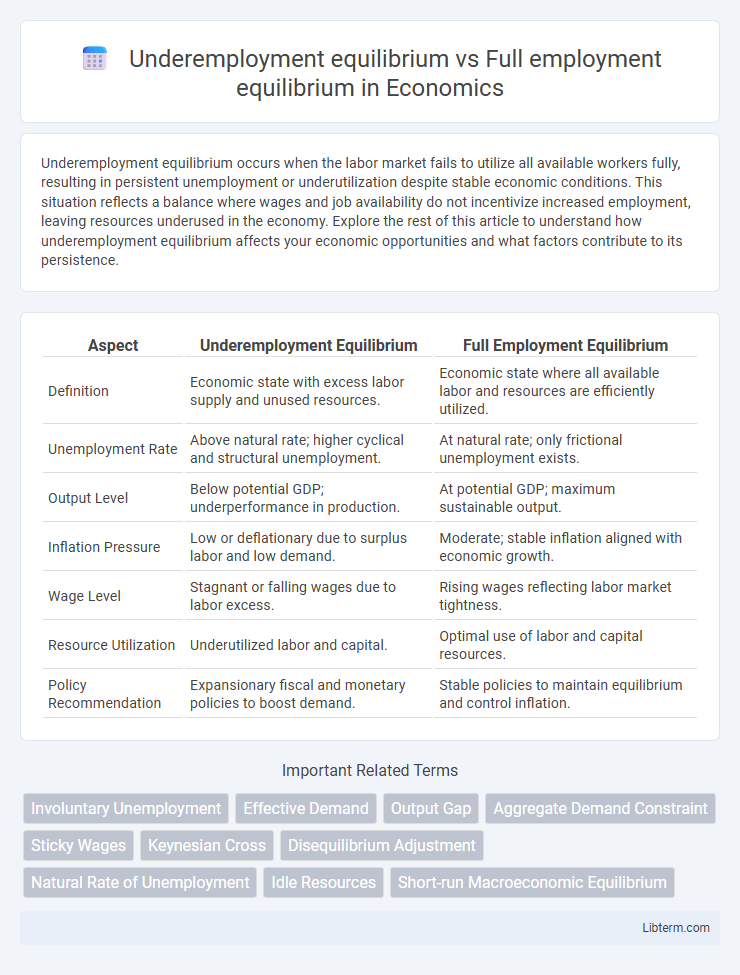Underemployment equilibrium occurs when the labor market fails to utilize all available workers fully, resulting in persistent unemployment or underutilization despite stable economic conditions. This situation reflects a balance where wages and job availability do not incentivize increased employment, leaving resources underused in the economy. Explore the rest of this article to understand how underemployment equilibrium affects your economic opportunities and what factors contribute to its persistence.
Table of Comparison
| Aspect | Underemployment Equilibrium | Full Employment Equilibrium |
|---|---|---|
| Definition | Economic state with excess labor supply and unused resources. | Economic state where all available labor and resources are efficiently utilized. |
| Unemployment Rate | Above natural rate; higher cyclical and structural unemployment. | At natural rate; only frictional unemployment exists. |
| Output Level | Below potential GDP; underperformance in production. | At potential GDP; maximum sustainable output. |
| Inflation Pressure | Low or deflationary due to surplus labor and low demand. | Moderate; stable inflation aligned with economic growth. |
| Wage Level | Stagnant or falling wages due to labor excess. | Rising wages reflecting labor market tightness. |
| Resource Utilization | Underutilized labor and capital. | Optimal use of labor and capital resources. |
| Policy Recommendation | Expansionary fiscal and monetary policies to boost demand. | Stable policies to maintain equilibrium and control inflation. |
Understanding Employment Equilibriums
Employment equilibriums reflect the balance between labor supply and demand, where underemployment equilibrium occurs when available jobs do not fully utilize workers' skills or hours, leading to inefficiencies in the labor market. Full employment equilibrium signifies a state where all willing and able workers find jobs matching their skill levels, without cyclical unemployment, indicating optimal resource allocation. Analyzing these equilibriums involves understanding labor market dynamics, wage flexibility, and structural factors influencing employment rates.
Defining Underemployment Equilibrium
Underemployment equilibrium occurs when an economy operates below full capacity, with persistent unemployment or underutilization of labor despite stable output levels. This situation contrasts with full employment equilibrium, where all available labor resources are efficiently utilized without cyclical unemployment. Underemployment equilibrium highlights inefficiencies in labor markets and can result from insufficient aggregate demand or structural imbalances.
Explaining Full Employment Equilibrium
Full employment equilibrium occurs when an economy operates at its maximum sustainable output without causing inflation, meaning all available labor resources are utilized efficiently. It reflects a balance where unemployment exists only at the natural rate, including frictional and structural unemployment, but no cyclical unemployment. This state ensures stable prices and steady economic growth, representing the ideal condition for long-term economic health.
Key Characteristics of Underemployment Equilibrium
Underemployment equilibrium occurs when the labor market reaches a stable state with persistent unemployment or underutilization of labor resources despite available job opportunities, reflecting inefficiencies in matching workers to jobs. It is characterized by a deficiency in aggregate demand, leading to idle capacity and wages that do not adjust downward to restore full employment. Contrarily, full employment equilibrium signifies a balance where all willing workers find jobs at prevailing wages, and labor resources are optimally utilized without inflationary pressure.
Factors Leading to Underemployment Equilibrium
Underemployment equilibrium occurs when the labor market fails to absorb available workers into full-time roles despite job openings due to factors like wage rigidity, insufficient aggregate demand, and skill mismatches. In this state, unemployment persists because wages remain above the market-clearing level, reducing firm incentives to hire more employees and limiting overall economic output. Contrastingly, full employment equilibrium signifies a situation where all willing and able workers find suitable jobs at prevailing wages, reflecting optimal utilization of labor resources without cyclical unemployment.
Causes of Full Employment Equilibrium
Full employment equilibrium occurs when all available labor resources are being utilized efficiently, with unemployment limited to frictional or voluntary factors, driven by strong aggregate demand, stable wages, and flexible labor markets. Causes include effective government policies promoting economic growth, technological advancements enhancing productivity, and balanced inflation rates that maintain purchasing power. In contrast, underemployment equilibrium arises when labor and resources are underutilized due to weak demand, rigid wage structures, or structural mismatches in the labor market.
Economic Impacts of Underemployment
Underemployment equilibrium occurs when available labor resources are not fully utilized, causing lower productivity and reduced income levels. This underutilization leads to decreased consumer spending and slower economic growth compared to full employment equilibrium, where workforce capacity is maximized. Persistent underemployment can result in increased poverty rates and greater income inequality, hindering overall economic development.
Benefits of Achieving Full Employment
Achieving full employment equilibrium maximizes economic output by utilizing the entire labor force, reducing idle resources and increasing productivity. It fosters higher income levels and improved standards of living by minimizing underemployment, where workers are employed below their skill levels or capacity. Full employment equilibrium enhances social stability and efficiency, as labor market imbalances and welfare dependency decrease, promoting sustained economic growth.
Policy Interventions for Shifting Equilibriums
Policy interventions aimed at shifting from underemployment equilibrium to full employment equilibrium often include fiscal stimulus measures such as increased public spending and tax cuts to boost aggregate demand. Monetary policies like lowering interest rates encourage investment and consumption, facilitating higher employment levels. Structural reforms targeting labor market flexibility and skill development also play a crucial role in transitioning towards full employment equilibrium by addressing mismatches between labor supply and demand.
Comparative Analysis: Underemployment vs Full Employment
Underemployment equilibrium occurs when labor resources are underutilized, resulting in unemployment despite the presence of job vacancies, while full employment equilibrium signifies the optimal utilization of labor where only frictional unemployment exists. Underemployment equilibrium reflects inefficient allocation and lower output levels, causing a persistent output gap, whereas full employment equilibrium aligns with maximum sustainable output and stable inflation rates. The distinction impacts fiscal and monetary policy decisions, as underemployment demands stimulation to increase demand, whereas full employment focuses on controlling inflationary pressures.
Underemployment equilibrium Infographic

 libterm.com
libterm.com